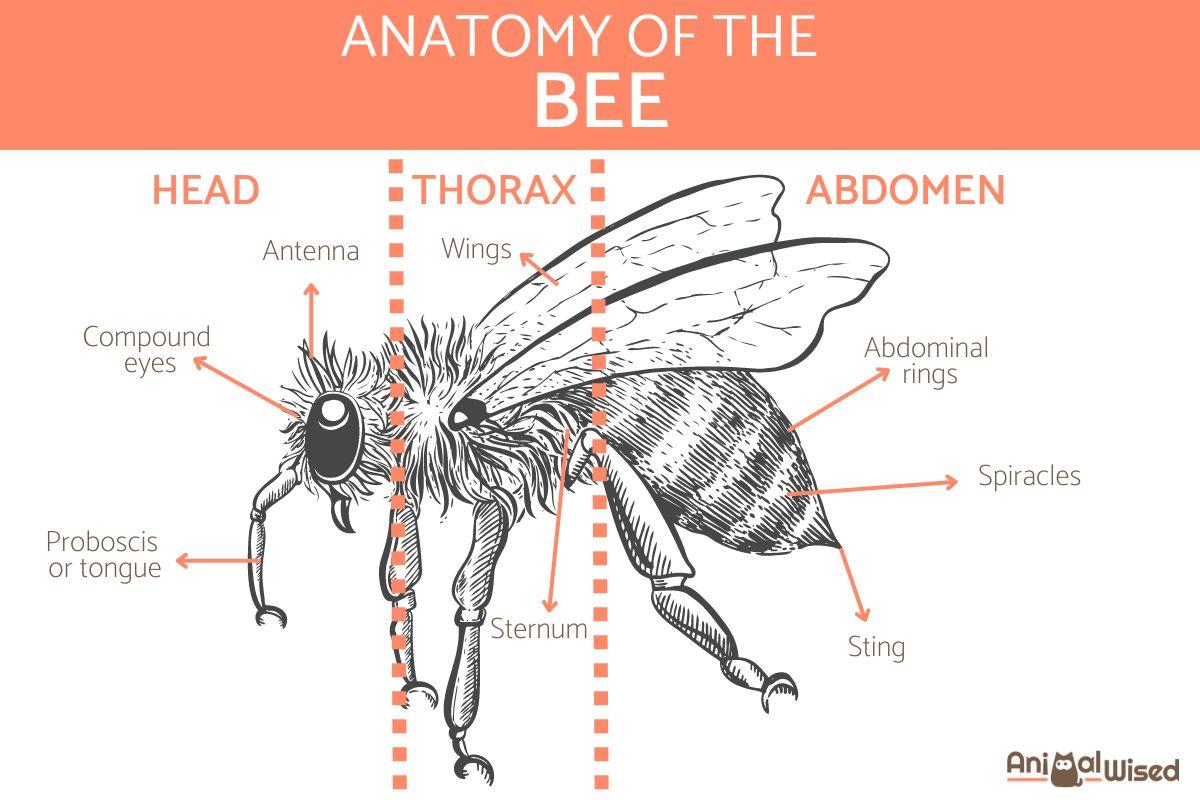What Are the Parts of the Bee?


Bees are fascinating creatures that play a vital role in our ecosystem as important pollinators. Their beauty and significance are undeniable. To better understand these incredible insects, it is essential to explore the different parts that make up their anatomy. From their bodies to their specialized organs, each component of bees plays a crucial role in their survival and the balance of nature.
In this AnimalWised article, we will take a detailed look at the three main parts of bees, examining how each contributes to their uniqueness and adaptability.
Head of the bees
The head of a bee is a complex structure with specialized parts that play vital roles in the functioning and behavior of these social insects. Let's explore the main components of a bee's head:
Compound eyes
Bees have compound eyes composed of numerous ommatidia, which are individual visual units acting like small lenses. These ommatidia contain light-sensitive cells called photoreceptors, allowing bees to perceive a wide range of colors, including ultraviolet. This ultraviolet vision helps bees find flowers by detecting color patterns and signals visible only to them.
Simple eyes
Bees have three ocelli on the top of their head. While not providing clear vision, these ocelli are sensitive to light and help bees detect changes in light intensity. They assist in maintaining balance during flight and navigating by using references such as the sun's position.
Antennas
Bee antennas are highly sensitive and serve multiple functions. They are covered in small structures called sensilla, which respond to different chemical and tactile stimuli. The antennas enable bees to detect pheromones, aiding communication and social organization within the hive. They also help bees identify odors and tastes in the environment, essential for finding nectar sources and recognizing potential threats.
Jaws
Bees' jaws are strong, toothed structures used to collect pollen from flowers and manipulate materials in the hive. They also serve as a defense mechanism, allowing worker bees to bite and incapacitate intruders. The jaws are specialized according to each bee's role within the hive, such as feeding larvae or constructing wax combs.
Proboscis or tongue
The proboscis is a flexible tube-like structure that bees use to collect nectar from flowers. It consists of two tubular parts called lacinia, covered with tiny taste buds. Bees extend their proboscis into flowers to access nectar, and the taste buds help them evaluate its quality. The length of the proboscis varies among bee species and is adapted to the types of flowers they visit.
For more information, be sure to read this other article, where we talk about how do bees communicate.

Thorax of the bees
The thorax of a bee plays a critical role in its locomotion, housing key components that facilitate flight and mobility. It encompasses the wings, legs, sternum, and flight muscles, working in harmony to enable bees to fly, forage, communicate, and carry out their daily tasks within the hive. Let's explore the main parts of a bee's thorax:
Wings
The bee's thorax contains two pairs of wings: the forewings and hindwings.
These wings are membranous and connected to the exoskeleton of the thorax. Bees have the ability to manipulate and adjust the position of their wings, generating different flight patterns. This flexibility allows them to perform fast, fluttering movements while gathering nectar and slower, hovering flight during flower pollination. When not in flight, bees can fold their wings back, facilitating movement within the hive.
Legs
Bees possess three pairs of legs attached to their thorax. Each leg consists of several parts, including the femur, tibia, and tarsus. These legs are specialized and adapted for various functions.
- The front legs feature comb-like structures used for cleaning and maintaining the antennae and mouthparts. They also aid in pollen manipulation and collection.
- The middle legs are responsible for collecting and transporting pollen.
- The hind legs possess pollen baskets, known as corbicula, where forager bees store their pollen loads. Additionally, the legs enable bees to walk, climb, and manipulate materials within the hive.
Sternum
The sternum is a ventral plate located on the bee's thorax. It serves as the attachment point for the flight muscles. These flight muscles extend from the sternum to the wings, rapidly contracting and relaxing to facilitate the movement of the wings during flight. In worker bees, the sternum also contains wax glands that produce small flakes of wax used for building combs and storing honey and pollen within the hive.
Flight muscles
Bees possess highly developed flight muscles in their thorax. These muscles consist of two main groups: the direct and indirect flight muscles. The direct muscles control the movement of the forewings, while the indirect muscles are responsible for the movement of the hindwings.
The coordinated contraction and relaxation of these flight muscles allow bees to fly, change direction, and maintain balance in the air. Worker bees, being primarily responsible for nectar and pollen collection, have particularly well-developed flight muscles.

Abdomen of the bees
The abdomen of bees is a vital part of their body, encompassing various organs and performing essential functions such as respiration, digestion, wax production, and reproduction. Let's explore the key parts of a bee's abdomen:
Abdominal rings
The abdomen consists of several segments or rings that are connected by flexible membranes. These segments allow for mobility and flexibility in the abdomen during different activities, such as foraging, excretion, and defense. The abdominal segments contain muscles that aid in the contraction and relaxation of the abdomen.
Wax glands
Worker bees possess wax glands located in their lower abdomen. These glands produce waxy scales. When bees need to construct new combs or repair existing ones, they secrete liquid wax through small pores in the abdominal segments. They manipulate and shape the wax using their jaws and feet to create the characteristic hexagonal cells of the combs.
Spiracles
Bees have spiracles, which are small openings in the abdominal segments that serve as respiratory structures. These spiracles are covered with tiny hairs that act as filters, preventing unwanted particles from entering the bees' respiratory system. Spiracles play a crucial role in gas exchange, allowing bees to take in oxygen from the air and release carbon dioxide produced during cellular respiration.
Digestive organs
The abdomen houses the main digestive organs, including the crop and stomach. The crop, also known as the anterior esophagus, is an expansion of the digestive tract that stores and transports collected nectar from the mouth to the stomach. Digestive enzymes process the stored nectar, and the mixture then passes into the stomach, referred to as the honey crop. In the stomach, further digestion occurs, and the sugars are absorbed, providing energy for the bees.
Reproductive organs
Within the abdomen, bees have reproductive organs. In worker bees, these organs are underdeveloped and nonfunctional. However, in queen bees, the abdomen contains well-developed ovaries responsible for producing and maturing eggs. Queen bees are the only fertile members of the hive and play a vital role in reproduction by laying eggs, ensuring the continuation of the colony.
If you want to read similar articles to What Are the Parts of the Bee?, we recommend you visit our Facts about the animal kingdom category.
- de Lello, E. (1971). Adnexal glands of the sting apparatus of bees: Anatomy and histology, I (Hymenoptera: Colletidae and Andrenidae) . Journal of the Kansas Entomological Society, 5-13.
- Faux, C.M. (2021). Honey Bee Anatomy. Honey Bee Medicine for the Veterinary Practitioner , 33-40.
- Ferreira, A., Abdalla, FC, Kerr, WE, & Cruz-Landim, CD (2004). Comparative anatomy of the male reproductive internal organs of 51 species of bees . Neotropical Entomology, 33, 569-576.
- Ruppert, R., & Barnes, R. (1997). Invertebrate zoology . Editorial Mc Graw-Hill–Interamericana, SA 6th. Edition. Mexico.







